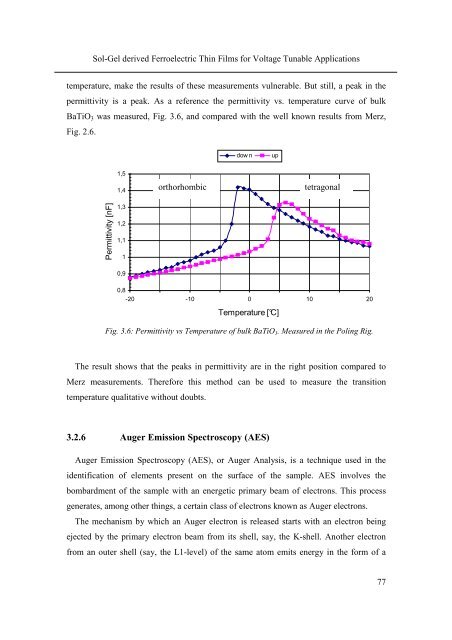PhD Thesis Arne Lüker final version V4 - Cranfield University
PhD Thesis Arne Lüker final version V4 - Cranfield University
PhD Thesis Arne Lüker final version V4 - Cranfield University
You also want an ePaper? Increase the reach of your titles
YUMPU automatically turns print PDFs into web optimized ePapers that Google loves.
Sol-Gel derived Ferroelectric Thin Films for Voltage Tunable Applications<br />
temperature, make the results of these measurements vulnerable. But still, a peak in the<br />
permittivity is a peak. As a reference the permittivity vs. temperature curve of bulk<br />
BaTiO3 was measured, Fig. 3.6, and compared with the well known results from Merz,<br />
Fig. 2.6.<br />
Permittivity [nF]<br />
1,5<br />
1,4<br />
1,3<br />
1,2<br />
1,1<br />
1<br />
0,9<br />
0,8<br />
-20<br />
Fig. 3.6: Permittivity vs Temperature of bulk BaTiO3. Measured in the Poling Rig.<br />
The result shows that the peaks in permittivity are in the right position compared to<br />
Merz measurements. Therefore this method can be used to measure the transition<br />
temperature qualitative without doubts.<br />
3.2.6 Auger Emission Spectroscopy (AES)<br />
-10<br />
dow n up<br />
orthorhombic tetragonal<br />
Auger Emission Spectroscopy (AES), or Auger Analysis, is a technique used in the<br />
identification of elements present on the surface of the sample. AES involves the<br />
bombardment of the sample with an energetic primary beam of electrons. This process<br />
generates, among other things, a certain class of electrons known as Auger electrons.<br />
The mechanism by which an Auger electron is released starts with an electron being<br />
ejected by the primary electron beam from its shell, say, the K-shell. Another electron<br />
from an outer shell (say, the L1-level) of the same atom emits energy in the form of a<br />
0<br />
Temperature [°C]<br />
10<br />
20<br />
77

















